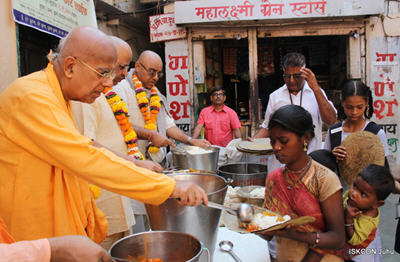|
Tantra – the Advanced Spiritual Science
Tantra is pure spiritual science which is not well known. The root word “tan” means continuation or expansion. Another root word Tantr means to rule, to govern, and to keep in order. Tantra means expansion of individual consciousness into universal consciousness. The science of Tantra stresses on the three aspects of human existence – physical desire, psychic urge and extreme love for the God. In tantric texts, gross body, astral body and causal body is mentioned as Om, Tat & Sat respectively. Tantra is widely misconceived. In fact, it is a systematic step by step approach with rigorous physical and psychological discipline to achieve spiritual enlightenment. Tantra aims to liberate and transform the mind and body from their natural impulses and binding impurities instead of supressing them, and make them fit for self-absorption and self-realization. Different postures, breathing and meditation techniques, and self-purification practices are used for this purpose. Steps of Tantra
Tantra, Mantra & Seven Chakras The ancient yogis found seven principle psychic-spiritual energy centres in the human body which emanates different sounds. These sounds are found in the alphabet of Sanskrit, and certain combinations of the sounds were used in ancient processes of concentration and meditation. Sound vibrations with special characteristics are mantras which liberate the mind. All mantras are repeated in synchronization with the inhalation and exhalation of breathing. The mantra acts as dynamo and helps the individual to associate his or her own individual consciousness with universal consciousness. Seven Chakras start from end of spine to the crown of head. These are Muladhara (location-perineum, shape-square having triangle with lotus having drooping petals, serpent lying in inactive state, end of spine, element – earth, colour-yellow), Svadhishtana (location-below naval, shape-crescent moon, towards back, element–water, colour-silver), Manipura (location-naval centre, shape-triangle with apex down, element-fire, colour-red), Anahata (location-near heart, shape-hexagram, element-air, colour-blue), Visshuda (location-at level of throat, shape-oval, and element-space, colour-dark indigo or black), Ajna (location-between eye brows, shape-winged globe, element-mind) and Sahasrara (location-below crown, shape-Thousands Petal lotus, element – consciousness, colour-crimson red). Lower five chakras are represented as gross body. Astral body travels from vishudha chakra (centre of knowledge,) to Ajna Chakra (soul centre). The causal body can be felt, when immersed in sahasrara chakra (just below the crown). There are three nerves run in the spine, in left is Ida, in right is Pingla and in centre is Sushumna. Sushumna runs a hollow path called as Kula Path. During the upward journey of Kundalini (subtle energy, parashakti), coursing through the Sushumna channel and the chakras along the way, it is finally brought to the crown chakra, Sahasrara. This union is the realization of the Absolute. Stages in Tantra Tantra has four stages viz. Jnanapada (path of self-knowledge), Yogapada (path of self-discipline), Kriyapada (path of spiritual practice) and Caryapada (path of spiritual evolution).
0 Comments
Act of giving - Charity, Donation or दान
Family values, upbringing and religion all play a part in giving in India, with Hinduism mandating giving. Donations reduce attachment to sensual pleasure. Donations are simplest way open all the lumps before death. The detachment begins by donations and forgiveness. However, if charity or donation is inadequate, done with repentance or given to ineligible, then it is worthless. In Vedas, service, charity and benevolence have been attributed to paramount religion. Rigveda (verse – 3.24.5) says, “शतहस्त समाहर सहस्त्र हस्त सं किर” means earn with hundreds of hands and donate with thousands of hands. The World Giving Index (WGI) is an annual report published (2016) by the Charities Aid Foundation, using data gathered by Gallup, and ranks over 140 countries in the world according to how charitable they are. This annual index measures generosity by three factors: the amount of money donated, participation in volunteering, and helping a stranger. Myanmar despite country in lower middle income claims the title of the world’s most generous country consistently for last three years 2014, 2015 & 2016. (USA – 2nd; Australia – 3rd; New Zealand – 4th; Sri Lanka – 5th; India – 91) Top 5 most charitable people in the world are Bill Gates (Net worth 84.2 billion, life time donation $27 billion), Warren Buffett (Net worth: $61 billion, life time donations $21.5 billion), George Soros (Net worth: $24.4 billion, life time donations $8 billion), Azim Premji (Net worth $15.9 billion, life time donations $8 billion) and Charles Francis Feeney (Net worth $1.5 million, life time donation $6.3 billion). In various Hindu scriptures such as Puranas, Mahabharata, Ramcharitramanas etc., importance of donation or daan has been highlighted. Shree Krishna in Shrimad Bhagavad Gita has explained three types of donations as under:
Hindu scriptures have dealt with the various aspects of donations such why donate, what to donate, who to donate, how to donate, when to donate and exemplary stories of donations. Such details with relevant quotations in Sanskrit are as under: |
Archives
July 2024
Categories |


 RSS Feed
RSS Feed